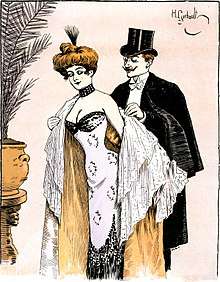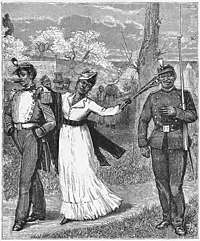Flirting
Flirting or coquetry is a social and sexual behavior involving spoken or written communication, as well as body language, by one person to another, either to suggest interest in a deeper relationship with the other person, or if done playfully, for amusement.

In most cultures, it is socially disapproved for a person to make explicit sexual advances in public, or in private to someone not romantically acquainted, but indirect or suggestive advances may at times be considered acceptable.
Flirting usually involves speaking and behaving in a way that suggests a mildly greater intimacy than the actual relationship between the parties would justify, though within the rules of social etiquette, which generally disapproves of a direct expression of sexual interest in the given setting. This may be accomplished by communicating a sense of playfulness or irony. Double entendres (where one meaning is more formally appropriate, and another more suggestive) may be used. Body language can include flicking the hair, eye contact, brief touching, open stances, proximity, and other gestures. Flirting may be done in an under-exaggerated, shy or frivolous style. Vocal communication of interest can include, for example,
- alterations in vocal tone (such as pace, volume, and intonation),
- challenges (including teasing, questions, qualifying, and feigned disinterest), which may serve to increase tension, and to test intention and congruity, and
- adoration which includes offers, approval and tact, knowledge and demonstration of poise, self-assurance, smart and stylish, a commanding attitude.
Flirting behavior varies across cultures due to different modes of social etiquette, such as how closely people should stand (proxemics), how long to hold eye contact, how much touching is appropriate and so forth.[1] Nonetheless, some behaviors may be more universal. For example, ethologist Irenäus Eibl-Eibesfeldt found that in places as different as Africa and North America, women exhibit similar flirting behavior, such as a prolonged stare followed by a head tilt away with a little smile, as seen in the accompanying image associated with a Hollywood film.
Etymology
The origin of the word flirt is obscure. The Oxford English Dictionary (first edition) associates it with such onomatopoeic words as flit and flick, emphasizing a lack of seriousness; on the other hand, it has been attributed to the old French conter fleurette, which means "to (try to) seduce" by the dropping of flower petals, that is, "to speak sweet nothings". While old-fashioned, this expression is still used in French, often mockingly, but the English gallicism to flirt has made its way and has now become an anglicism.[2]
The word fleurette was used in the 16th century in some sonnets,[3] and some other texts.[4][5][6] The French word fleurette (small flower), and the language of old south France word flouretas (from the Latin flora(for flower)), are related to some little says where flowers are both at the same time a pretext and the comparison terms. In southern France, some usage were yet used in 1484,[7][8] In French, some other words more or less related are derived from the word fleur: for instance effleurer (English: lightly touch) from 13th century esflourée; déflorer (English: deflower) from 13th century desflorer or (fleuret (English Foil) 18th century).
The association of flowers, spring, youth, and women is not modern and were yet considered in ancient culture, such as the Chloris in ancient Greece, or Flora (deity) in the ancient Roman Empire, including Floralia festival, and in other older poems, such as the Song of Songs.
History
During World War II, anthropologist Margaret Mead was working in Britain for the British Ministry of Information and later for the U.S. Office of War Information,[9][10] delivering speeches and writing articles to help the American soldiers better understand the British civilians,[11] and vice versa.[12] She observed in the flirtations between the American soldiers and British women a pattern of misunderstandings regarding who is supposed to take which initiative. She wrote of the Americans, "The boy learns to make advances and rely upon the girl to repulse them whenever they are inappropriate to the state of feeling between the pair", as contrasted to the British, where "the girl is reared to depend upon a slight barrier of chilliness... which the boys learn to respect, and for the rest to rely upon the men to approach or advance, as warranted by the situation." This resulted, for example, in British women interpreting an American soldier's gregariousness as something more intimate or serious than he had intended.[9]
Communications theorist Paul Watzlawick used this situation, where "both American soldiers and British girls accused one another of being sexually brash", as an example of differences in "punctuation" in interpersonal communications. He wrote that courtship in both cultures used approximately 30 steps from "first eye contact to the ultimate consummation", but that the sequence of the steps was different. For example, kissing might be an early step in the American pattern but a relatively intimate act in the English pattern.[13]
Japanese courtesans had another form of flirting, emphasizing non-verbal relationships by hiding the lips and showing the eyes, as depicted in much Shunga art, the most popular print media at the time, until the late 19th century.
European hand fans
The fan was extensively used as a means of communication and therefore a way of flirting from the 16th century onwards in some European societies, especially England and Spain. A whole sign language was developed with the use of the fan, and even etiquette books and magazines were published. Charles Francis Badini created the Original Fanology or Ladies' Conversation Fan which was published by William Cock in London in 1797. The use of the fan was not limited to women, as men also carried fans and learned how to convey messages with them. For instance, placing the fan near the heart meant "I love you", while opening a fan wide meant "Wait for me".[14]
In Spain, where the use of fans (called "abanicos") is still very popular today, ladies used them to communicate with suitors or prospective suitors without attracting the notice of their families or chaperons. This use was highly popular during the 19th and early 20th centuries.[15]
Purpose

People flirt for a variety of reasons. According to social anthropologist Kate Fox, there are two main types of flirting: flirting just for fun and flirting with further intent.[16]
In a 2014 review, Henningsen made a further distinction and identified six main motivations for flirting: sex, relational development, exploration, fun, self-esteem and instrumental.[17] Henningsen found that often, many flirting interactions involve more than one of these motives. There also appears to be gender differences in flirting motivations.
Courtship
Many people flirt as a courtship initiation method, with the aim of engaging in a sexual relationship with another person. In this sense, flirting plays a role in the mate-selection process. The person flirting will send out signals of sexual availability to another, and expects to see the interest returned in order to continue flirting. Flirting can involve non-verbal signs, such as an exchange of glances, hand-touching, and hair-touching; or verbal signs, such as chatting, giving flattering comments, and exchanging telephone numbers in order to initiate further contact.
Many studies have confirmed that sex is a driving motivation for flirting behaviours.[17] Additionally, Messman and colleagues' study provided support for this hypothesis; it demonstrated that, the more one was physically attracted to a person, the higher the chances one would flirt with them.[18]
Flirting in the goal of signalling interest appears as a puzzling phenomenon when considering that flirting is often performed very subtly. In fact, evidence shows that people are often mistaken in how they interpret flirting behaviours.[18] Thus, if a main purpose of flirting is to signal interest to the other person, why isn't this signalling done more clearly and explicitly?
A possible explanation, for the ambiguous nature of human flirting lies in the costs associated with courtship signals. Indeed, according to Gersick and colleagues, signalling interest can be costly as it can lead to the disturbance of the nature of a relationship.[19] For instance, signalling sexual interest to a friend bears the risk of introducing uncertainty into the friendship, especially if the romantic advance is rejected by the recipient. For this reason, individuals prefer engaging in a flirting interaction that is more subtle to limit the risks associated with the expression of sexual interest.
More generally, human relationships are governed by social norms and whenever these are broken, one can suffer significant costs that can range from social, economic and even legal nature. As an illustration, a manager flirting with his subordinate can lead to strong costs such as being accused of sexual harassment, which can potentially lead to job loss.
Additionally, third parties can impose costs on someone expressing sexual interest.[20] Expressing sexual interest to somebody else's romantic partner is a highly punishable act. This often leads to jealousy from the person's partner which can trigger anger and (possible) physical punishment, especially in men.[21] Third parties can also impose costs through the act of eavesdropping. These can lead to damage to one's reputation leading to possible social, economic and legal costs.
A last point to consider is that the costs associated with interest signalling are magnified in the case of humans, when compared to the animal world. Indeed, the existence of language means that information can circulate much faster. For instance, in the case of eavesdropping, the information overhead by the eavesdropper can be spread to very large social networks, thereby magnifying the social costs.[22]
Other motivations
Another reason people engage in flirting is to consolidate or maintain a romantic relationship with their partner. They will engage in flirting behaviours to promote the flourishing of their relationship with their partner. People will also flirt in the goal of 'exploring'. In this sense, the aim is not necessarily to express sexual or romantic interest but simply to assess whether the other might be interested in them before making any decision about what they would want from that individual.
Henningsen and Fox also demonstrated that flirting can sometimes be employed just for fun. For instance, studies have shown that flirting in the workplace was used mostly for fun purposes.[17]
Another motive that drives flirting is developing one's own self esteem. People often feel highly valued when someone flirts with them. Therefore, often people flirt to encourage reciprocation and thereby increase their self esteem. As a last point, people might flirt for instrumental purposes. For instance, they will flirt to get something out of the other person such as drink in a nightclub or a promotion at work.
Gender differences in motivations
Certain types of flirting seem to be more common amongst males compared to females and vice versa.
To start with, Henningsen and colleagues' study demonstrated that flirting with sexual intent was found to be more prominent amongst men. On the other hand, flirting for relationship development purposes was more often employed by women.[17]
These findings are not surprising when the parental investment theory is taken into account. First, it states that females are more choosy and men more competitive, therefore predicting that flirting as courtship initiation will be more commonly used amongst men. The theory also predicts that females invest more in their offspring, which makes them more prone to invest in their relationship as this can provide resources that can contribute to their offspring's survival. On the other hand, men have no guarantee that their mates' offspring is theirs, so have less incentives to seek long-term relationships; thereby explaining why men care less about flirting for relationship development.[23]
Additionally, Henningsen found that flirting for fun was more common in females than males. A possible explanation for this could lie in the fact that women engage in what he calls "practice flirting". As women are more selective and want to attract the best partner to take care of their offspring, they might flirt for fun to practice and evaluate what flirting behaviours work the best.[17]
Examples

Flirting may consist of stylized gestures, language, body language, postures, and physiologic signs which act as cues to another person. Among these, at least in Western society, are:
- Blowing a kiss
- Casual touching; such as gently stroking, touching each other's arms, chest and neck during flirting/heavy, intimate make-out sessions in preparation for sexual activity[24]
- Conversation (e.g. banter, small talk, pickup lines)[24]
- Coyness, marked by cute, coquettish shyness or modesty, coquet or playful aggrandizement of a partner's importance
- Eye contact,[24] batting eyelashes, or staring
- Eyebrow raising
- Flattery (e.g. regarding beauty, sexual attractiveness)
- Footsie,[24] a form of flirtation in which one uses their feet to play with another's
- Imitating or mirroring another's behavior (e.g. taking a drink when the other person takes a drink, changing posture as the other does, foreshadowing or mimicking someone's reactions to successful attraction etc.)
- Laughing, giggling, chuckling encouragingly at any slight hint of intimacy in the other's behavior
- Maintaining close proximity, such as during casual talking
- Nicknames and other terms of endearment to describe a partner's personality, beauty or sexiness
- Chatting online, texting, and using other one-on-one and direct messaging services, while hinting affection
- Protean signals or indicators of interest, such as touching one's hair, side-ways glance, and pointing one's chest towards partner's chest
- Writing love letters and notes, poems, or presenting small gifts
- Singing specially selected love songs as a declaration of love and devotion in presence of one's partner
- Smiling or grinning at partner and/or holding them close
- Staging of "chance" encounters and romantic rendezvous
- Sexting
- Teasing
- Tickling
- Winking
The effectiveness of many of these interactions has been subjected to detailed analysis by behavioral psychologists, and advice on their use is available from dating coaches.[25]
Cultural variations
Flirting varies a great deal from culture to culture. For example, for many western cultures one very common flirting strategy includes eye contact. However, eye contact can have a very different meaning in some Asian countries, where women might get in trouble if they return a glance to men who stare at them. Furthermore, Chinese and Japanese women are sometimes not expected to initiate eye contact as it could be considered rude and disrespectful.[26]

The distance between two people is also important when flirting. People from the "contact cultures", such as those in the Mediterranean or Latin America, may feel comfortable with closer proximity, whereas a British or Northern European person may typically need more space. Although touching, especially of the hand or arm, can constitute flirting, touching is also often done without intentions of flirting, particularly in the contact cultures where it forms a natural part of communication.[27]
References
- "Scoring a German: Flirting with Fräuleins, Hunting for Herren". Spiegel.de. Retrieved 2012-10-03.
- texte, Académie de Nîmes. Auteur du (9 August 1876). "Mémoires de l'Académie royale du Gard". Gallica.
- texte, La Taille, Jean de (1535?-1611?). Auteur du; texte, Arioste, L' (1474-1533). Auteur du; texte, La Taille, Jacques de (1542-1562). Auteur du (9 August 1573). "La famine, ou Les Gabéonites, tragédie prise de la Bible et suivant celle de Saül, ensemble plusieurs autres oeuvres poëtiques de Jehan de La Taille de Bondaroy..." Gallica.
- texte, Tabourot, Étienne (1549-1590). Auteur du; texte, Tabourot, Étienne (1549-1590). Auteur du (9 August 2018). "Les bigarrures et touches du seigneur des Accords . Avec les Apophtegmes du sieur Gaulard et les Escraignes dijonnoises. Dernière édition, reveue et de beaucoup augmentée". Gallica.
- texte, Guy de Tours (1562?-1611?). Auteur du; texte, Berthelot (15..-16.. ; poète satirique). Auteur du; texte, Béroalde de Verville, François (1556-1626). Auteur du; texte, Gauchet, Claude (1540-162.). Auteur du (9 August 2018). "Les muses incognues ou La seille aux bourriers plaine de désirs et imaginations d'amour : réimprimé textuellement et collationné sur l'exemplaire existant à la Bibliothèque de l'Arsenal à Paris ([Reprod. en fac-sim.]) / recueil de poésies satyriques de Béroalde de Verville, de Guy de Tours, de Gauchet, de Berthelot, de Motin, etc". Gallica.
- texte, Larivey, Pierre de (1540?-1619). Auteur du (9 August 2018). "Les comédies facécieuses de Pierre de Larivey, champenois . A l'imitation des anciens Grecs, Latins, & modernes Italiens. A sçavoir, le Laquais, la Veuve, les Esprits, le Morfondu, les Escolliers". Gallica.
- Revue des langues romanes
- Émile Littré, "fleurette", Dictionnaire de la langue française (in French)
- Mead, Margaret (2004). William O. Beeman (ed.). Studying Contemporary Western Society: Method and Theory. New York: Berghahn Books. pp. 145, 149. ISBN 978-1-57181-816-4.
- Mead's article, A Case History in Cross-National Communications, was originally published in Bryson, Lyman (1948). The Communication of Ideas. New York: Institute for Religious and Social Studies, dist. by Harper and Brothers. OCLC 1488507.
- e.g. Mead, Margaret (1944). The American troops and the British community. London: Hutchinson. OCLC 43965908.
- e.g. Mead, Margaret. "What Is a Date?". Transatlantic. 10 (June 1944). OCLC 9091671.
- Watzlawick, Paul (1983). How Real Is Real?. London: Souvenir Press. pp. 63–64. ISBN 978-0-285-62573-0.
- "Ladies and their Fans". Avictorian.com. Retrieved 2010-06-23.
- "The Language of the Fan". Spainforvisitors.com. Archived from the original on 2010-06-26. Retrieved 2010-06-23.
- Fox, Kate. "SRIC Guide to Flirting". Sirc.org. Retrieved 2019-03-21.
- Henningsen, David (2004). "Flirting with meaning: an examination of miscommunication in flirting interactions". Sex Roles. 50 (7–8).
- Messman, Susan J; Canary, Daniel J; Hause, Kimberly (2000). "Motives to Remain Platonic, Equity, and the Use of Maintenance Strategies in Opposite-Sex Friendships". Journal of Social and Personal Relationships. 16 (67–94): 67–94. doi:10.1177/0265407500171004.
- Gersick, Andrew; Kurzban, Robert (2014). "Covert Sexual Signaling: Human Flirtation and Implications for other Social Species". Evolutionary Psychology. 12 (3): 147470491401200. doi:10.1177/147470491401200305.
- Gersick, Andrew; Kurzban, Robert (2014). "Covert Sexual Signaling: Human Flirtation and Implications for other Social Species". Evolutionary Psychology. 12 (3): 147470491401200. doi:10.1177/147470491401200305.
- Buss, David; Schmitt, David (1993). "Sexual strategies theory: An evolutionary perspective on human mating". Psychological Review. Cite journal requires
|journal=(help) - Gersick, Andrew; Kurzban, Robert (2014). "Covert Sexual Signaling: Human Flirtation and Implications for other Social Species". Evolutionary Psychology. 12 (3): 147470491401200. doi:10.1177/147470491401200305.
- Campbell, Bernard (1972). Sexual selection and the descent of man. Aldine. pp. 1871–1971.
- Flirting. Sexplanations. 2014-03-25.
- Winter, Susan (2015-04-19). "The Dating Game of Hot and Cold". Huffington Post. Retrieved 2017-03-15.
- "Covert glances and eye contact". Brighthub.com. Archived from the original on 2010-04-10. Retrieved 2010-06-23.
- "SIRC Guide to Flirting". Sirc.org. Retrieved 2010-06-23.
| Wikimedia Commons has media related to Flirting. |
| Wikiquote has quotations related to: Flirting |
| Wikisource has original text related to this article: |